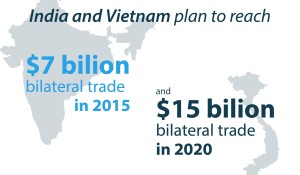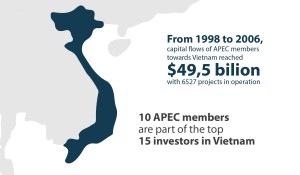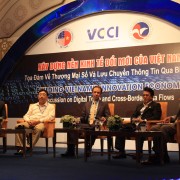Economic Context in the Greater Region and the World
Vietnam is party to several regional and global organizations. Ever since doi moi (“Renovation”) in 1986, institutions encouraging regional economic and financial cooperation between South Asian countries have played a major role in Vietnamese development. Below, we will examine some of various organizations and partnerships that Vietnam is a part of.
East Asia Summit (EAS)
Since 2005, the East Asia Summit encourages cooperation in several fields from energy to education. Concerning the economy and finance, the last summit in Brunei reaffirmed the common will to increase cooperation in economy and finance with more “liberal initiatives.” Myanmar will organize the 9th edition of the East Asia Summit in November, 2014.
Regional Comprehensive Economic Partnership (RCEP)
The Regional Comprehensive Economic Partnership aims to gather 10 ASEAN members and six non-ASEAN members to improve economic cooperation in the region. Today, RCEP totals 46% of the global population and generated 24% of the global GDP in 2012.
RCEP plans to standardize Free-Trade Agreement (FTA) rules to simplify its implementation by companies. Also, the establishment of common incentives serves to “democratize” the use of tax incentives for both large and small enterprises. According to Kohei Shiino, deputy director of JETRO (Japan External Trade Organization) Singapore, RCEP will “bring about big advantages for Vietnam’s garment and textile industry.” For example, the ASEAN-Japan tax incentives on exporting Vietnam-made goods in Japan only concern products with ASEAN or Japan origins. However, 33% of Vietnamese apparel materials cannot benefit from tax incentives due to their Chinese origins. The implementation of common incentives should help to avoid similar situations in the future.
Looking forward, the fifth round of negotiations in December in New Delhi, this economic partnership seems to have a bright future ahead of it. The Asian Development Bank argues that RCEP will increase revenues by 664 billion dollars in 2025 – which would equal 0.6% of the global GDP due to goods, services, assets and labor exchanges between these countries.
However, Vietnam will have to face the challenge of joining RCEP, while being an active member of the Trans-Pacific Partnership (TPP). The potential conflict between the TPP – led by the United States and RCEP, driven by China–(both wanting to shape economic partnerships with Southeast Asia countries) could put Hanoi in a difficult position. Indeed, both political and security implications in the context of an economic partnership can be conflicting between China’s and United States’ interests. Concerning the future role of Vietnam, ASEAN observers consider a potential split of Asian countries in two sides: Singapore, Malaysia and Vietnam would tend to turn to TPP whereas other ASEAN countries would strengthen trading relations with China through RCEP.
On a smaller scale, Vietnam has to consider China’s predominance in the trade balance between the two countries. Although crude oil and coal are exported to China, Vietnamese industries abundantly import Chinese goods as raw material, machinery and equipment, steel, chemicals, and oil and fabrics. (This situation is probably due to the differing economies in North and South Vietnam.)
Asia-Pacific Economic Cooperation (APEC)
Created in 1989, the Asia-Pacific Economic Cooperation includes 21 countries in the Pacific region and congregates 40% of the global GDP. Since the establishment of APEC, average trade barriers have dropped from 16.9% to 5.5% in 2004.
Looking at numbers, Vietnam takes advantage of being a member of such a organization: from 1998 to 2006, capital flows of APEC members towards Vietnam reached $49.5 billion with 6,527 projects in operation. Moreover, 10 APEC members are part of the top 15 investors in Vietnam. As a consequence, Vietnam will be able to rely on future solid financial and economic partnerships to accelerate its integration into the world economy.
Association of Southeast Asian Nations (ASEAN)
Since July 1995, Vietnam has taken part in the Association of Southeast Asian Nation with nine other states. The effective growth of trade between ASEAN and Vietnam reflects the success of the partnership. According to Louis Taylor, CEO of the Standard Chartered Bank in Vietnam, Laos and Cambodia, “ASEAN is the third-largest export market for Vietnam, accounting for more than 10 per cent of the country’s total exports … [and] the second-largest supplier to the country, accounting for 20 per cent of the nation’s total imports.” In 2010, Vietnam hosted summits concerning ASEAN solidarity and connectivity and expressed “its desire to fulfill the goal of building the ASEAN Community by 2015.” Although increasing regional economic cooperation will generate changes in Vietnam’s economy, one-to-one treaties and agreements with neighboring countries also impact the market.
In March 2014, on the occasion of a visit of the Vice President of Myanmar Nyan Tun in Vietnam, the two countries concluded a bilateral agreement on a common objective in trade. Vietnam remains the ninth-largest foreign investor with $370 million invested in Myanmar, let alone the 18 Vietnamese companies registered in Myanmar. Moreover, in 2012, the trade volume amounted to $66 million. Both sides want to reach $500 million in trade by 2015, thanks to cooperation in agro-forestry, fisheries, banking, telecommunications, transport, oil and gas and tourism.
Bilateral Trade Agreements
Vietnam is also working on increasing economic partnership with individual nations such as South Korea. On October 2nd, President Park Geun-hye met Nguyen Phu Trong, the general secretary of the Communist Party of Vietnam during his state visit in Korea. Both sides agreed on signing a free trade agreement before the end of the year and improve cooperation in building transportation infrastructure in Vietnam.
Additionally, in 2012, India and Vietnam announced their common objective to reach $7 billion bilateral trade in 2015 and $15 billion by 2020. The Indian government expressed its wish to facilitate the access of Indian banks to the Vietnamese market, in order to develop trade and investment between both countries. The implementation of India-ASEAN free trade agreement by Vietnam and India helped both countries to reach $4 billion in bilateral trade in 2012.
Moreover, Vietnam appears to be the land of opportunities for Japanese small and medium enterprises (SME): a survey from business associations in the East Asian country show that 50% of Japanese SMEs planning investment abroad consider coming to Vietnam. Therefore, it should come as no surprise that the Japan External Trade Organization in Ho Chi Minh City welcomed 2,400 Japanese investors considering investment opportunities in Vietnam between April 2011 and January 2012.
The Takeaway and Key Milestones
We can observe several trends in regards to trade in Vietnam: the first general trend is the expansion of the range of products concerned by free trade agreements. The second phenomenon is the common will of improving existing trade conditions between countries. Finally, Vietnam actively tries to develop its trading partnerships with neighboring countries and is moving to increase cooperation on many subjects as well as to deepen economic relationships with a wide range of current and potential partners.
For foreign investors, the Vietnamese market should also become more attractive to Thai retailers with the upcoming ASEAN Economic Community in 2015. Meanwhile, the Vietnamese retail market is expected to grow 12% in 2014. The major news is that the TPP could be finalized later this year—if so then expect relations between the US and Vietnam to become even closer. [Update: as of February, 2015, the TPP has still not been finalized but the US has announced that it intends to be Vietnam’s number one trading partner after the TPP becomes finalized.]
Thanks to Louis Boulay, who contributed to this week’s post.
Sources:
“50% of Japanese SMEs Want to Invest in Vietnam: Forum.” Tuoitrenews. Tuoitrenews, 15 Oct. 2014. Web. 20 Oct. 2014.
ASEAN, 2013, Statement & Communiques. “Regional Comprehensive Economic Partnership (RCEP) Joint Statement The First Meeting of Trade Negotiating Committee.” Regional Comprehensive Economic Partnership (RCEP) Joint Statement The First Meeting of Trade Negotiating Committee. ASEAN, 10 May 2013. Web. 20 Oct. 2014.
Chauhan, Sadhavi. “Vietnam’s Role in ASEAN.” East Asia Forum. East Asia Forum, 23 Oct. 2013. Web. 20 Oct. 2014.
Fujita, Mai. “Vietnam in APEC : Changes in Trade Pattern after the Open Door Policy.” Vietnam in APEC: Changes in Trade Patterns after the Open Door Policy (n.d.): n. pag. Ide-Jetro. Ide-Jetro. Web. 20 Oct. 2014.
Mehdudia, Sujay. “India-Vietnam Set a Trade Target of $7 Billion for 2015.” The Hindu. The Hindu, 1 Nov. 2012. Web. 20 Oct. 2014.
“Mid-Term Stocktake of Progress Towards the Bogor Goals and the Busan Roadmap to the Bogor Goals.” Asian-Pacific Economic Cooperation. Asian-Pacific Economic Cooperation, n.d. Web. 20 Oct. 2014.
NZST. “Regional Comprehensive Economic Partnership (RCEP).” Trade and Economic Relations. Trade and Economic Relations, 15 Sept. 2014. Web. 20 Oct. 2014.
Sojung, Yoon. “Korea, Vietnam Discuss Ways to Deepen Economic Cooperation.” Korea IT Times. Korea IT Times, 8 Oct. 2014. Web. 20 Oct. 2014.
Tran Thu, Tran. “Vietnam to Benefit Greatly from RCEP, Say Experts.” Vietnam to Benefit Greatly from RCEP, Say Experts. The Saigon Times, 18 June 2013. Web. 20 Oct. 2014.
Truong-Minh, Vu, and Nhat-Anh Nguyen. “The Potential of the TPP for Vietnam.” The Diplomat. The Diplomat, 4 Sept. 2014. Web. 19 Oct. 2014.
“Vietnam and APEC.” Vietnam and APEC. Vietnam and APEC, n.d. Web. 20 Oct. 2014.
“Vietnam and ASEAN.” Asean Vietnam Tourism, Trade and Relations. Asean Vietnam Tourism, Trade and Relations, n.d. Web. 20 Oct. 2014.
“Vietnam in ASEAN : Toward Cooperation for Mutual Benefits.” Vietnam in ASEAN : Toward Cooperation for Mutual Benefits. ASEAN, n.d. Web. 20 Oct. 2014.
“Vietnam: Trade Statistics.” GlobalEDGE: Your Source for Global Business Knowledge. GlobalEDGE: Your Source for Global Business Knowledge, n.d. Web. 19 Oct. 2014.
VNA. “Le Vietnam Au 5e Tour De Négociations Du RCEP à Singapour — Vietnam+ (VietnamPlus).” Le Vietnam Au 5e Tour De Négociations Du RCEP à Singapour. Vietnam+ (VietnamPlus), 30 June 2014. Web. 20 Oct. 2014.
VNA. “Vietnam, Mongolia Trade Unions Deepen Ties — Vietnam+ (VietnamPlus).” Vietnam +. Vietnam +, 18 Nov. 2013. Web. 20 Oct. 2014.
Yoon, Suthichai. “TPP vs. RCEP: A New Washington-Beijing Tug-of-war?” The Nation. The Nation, 6 Dec. 2012. Web. 20 Oct. 2014.












Trackbacks & Pingbacks
[…] be reduced to zero as part of ASEAN integration in the region–not to mention a host of other trade promotion vehicles that Vietnam is involved in at various stages. To some, the changes in Vietnam since 40 or even 20 […]
[…] a previous post, we explored Vietnam’s economic context in the region and the world but here is a quick rundown […]
Comments are closed.